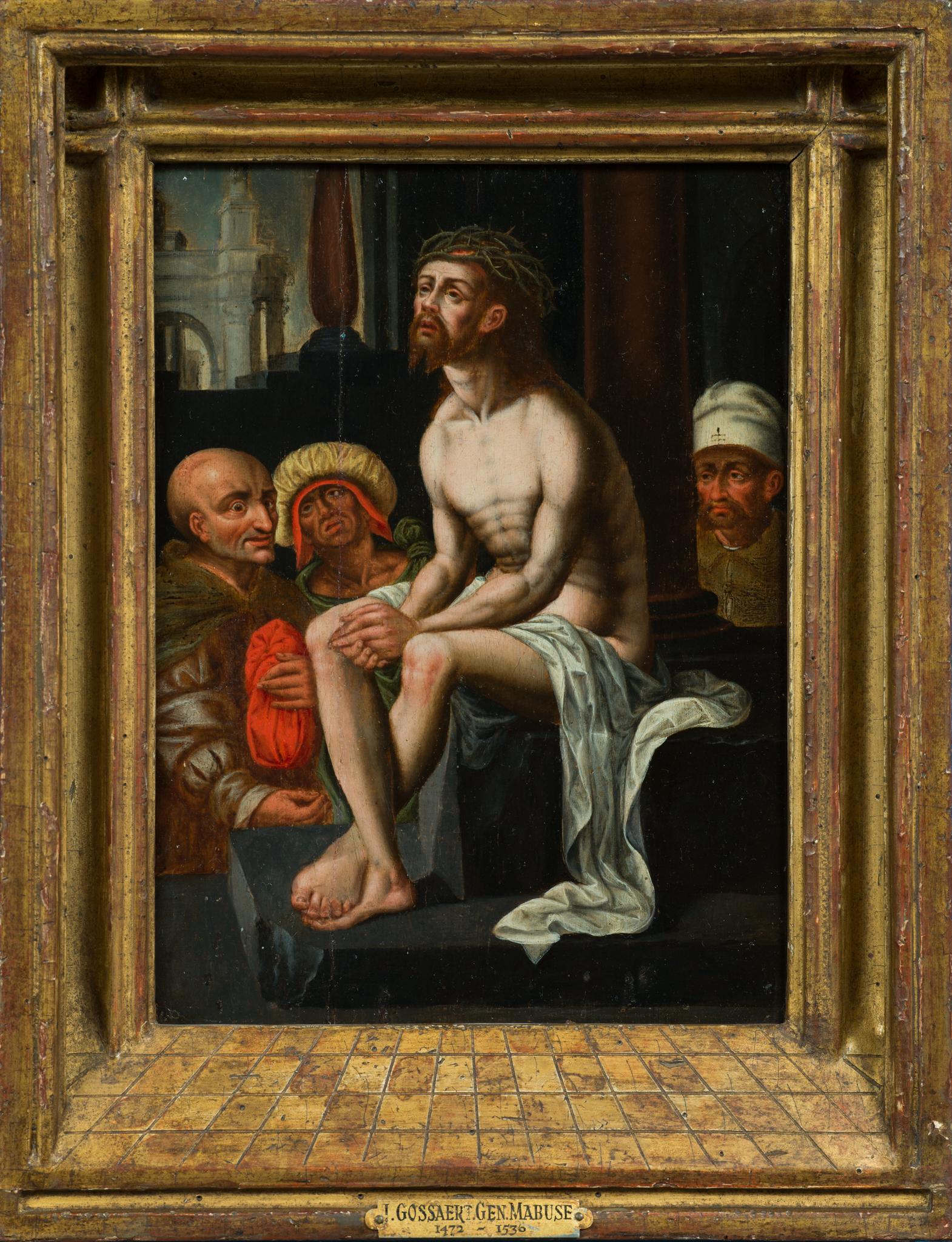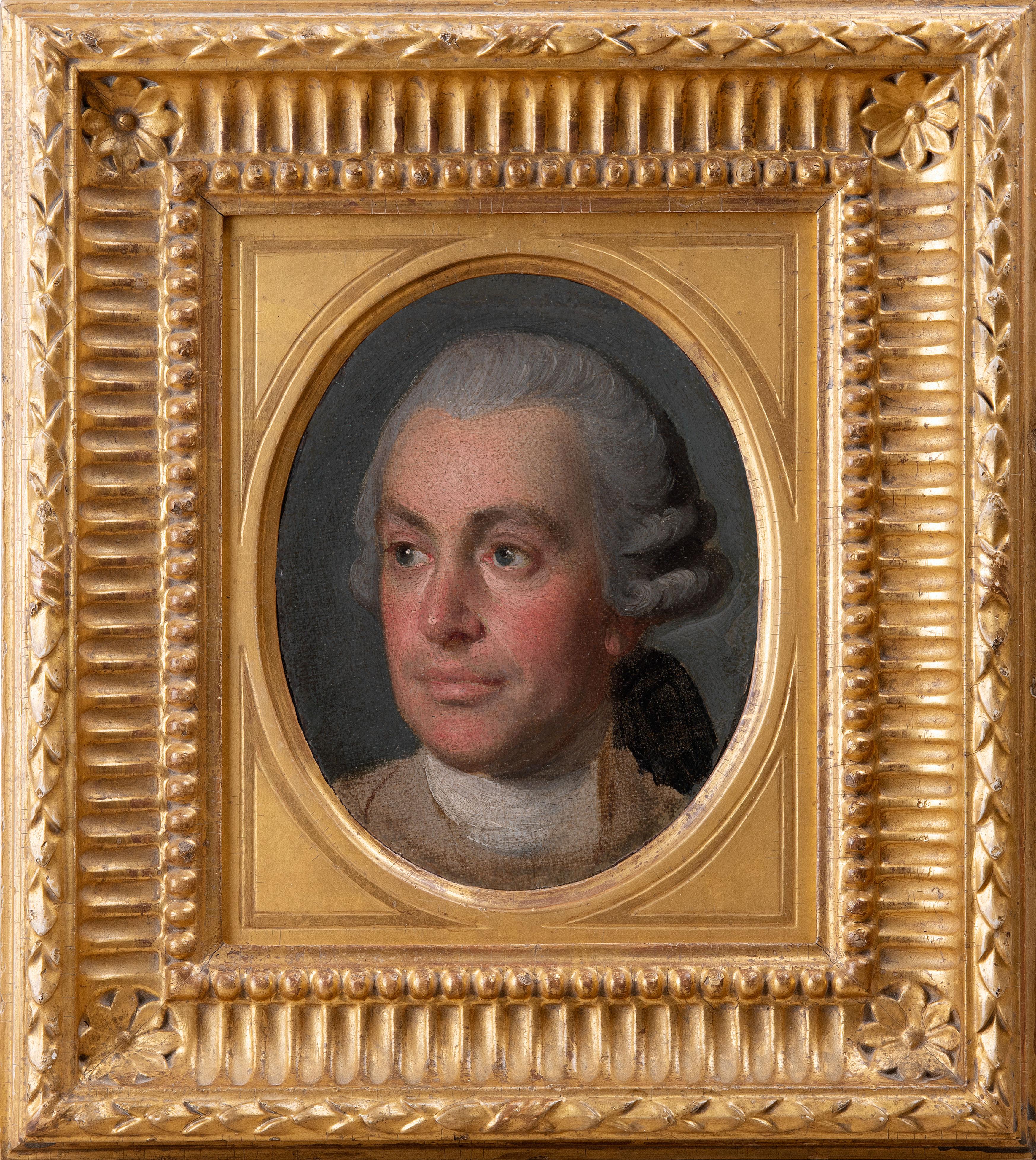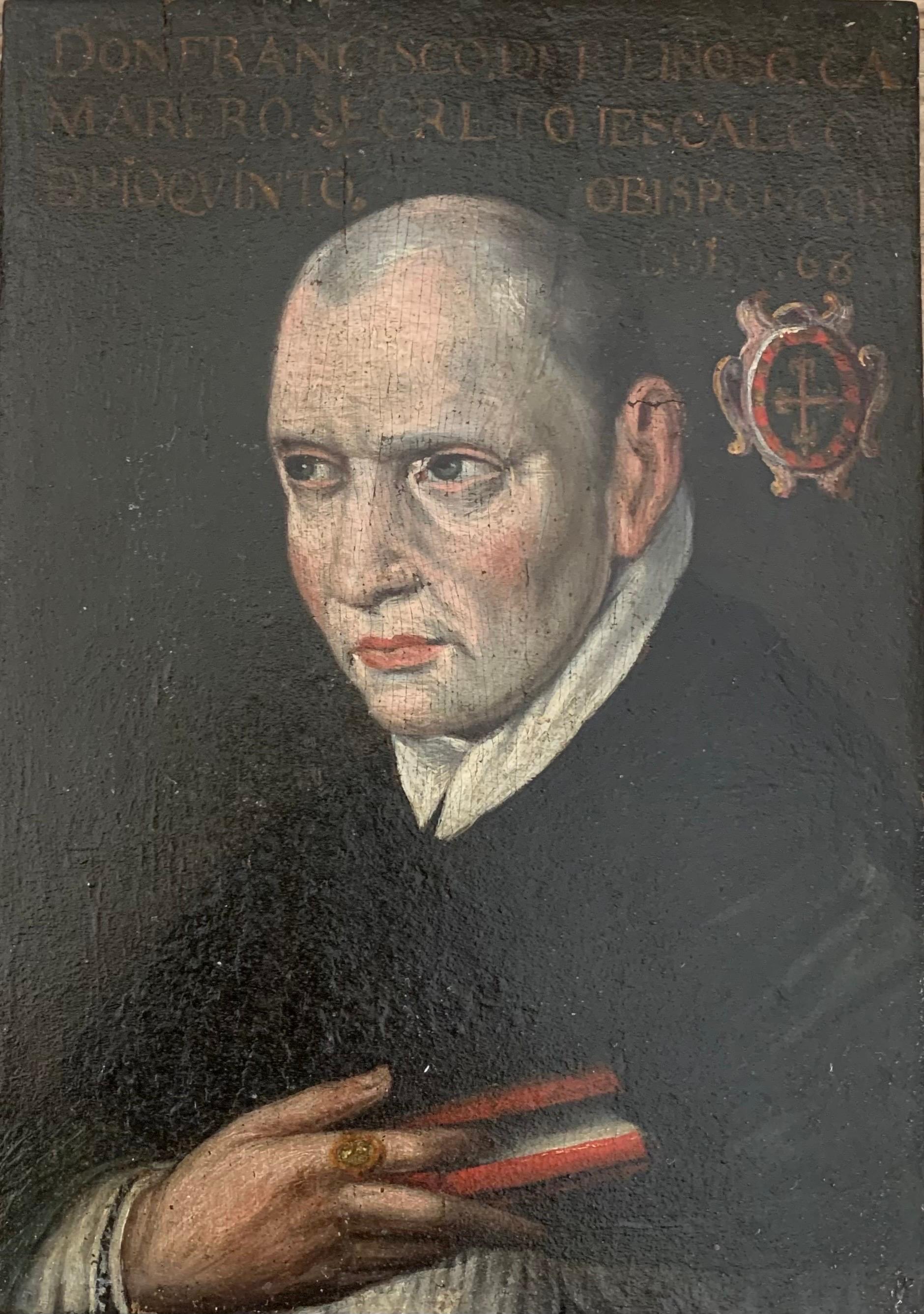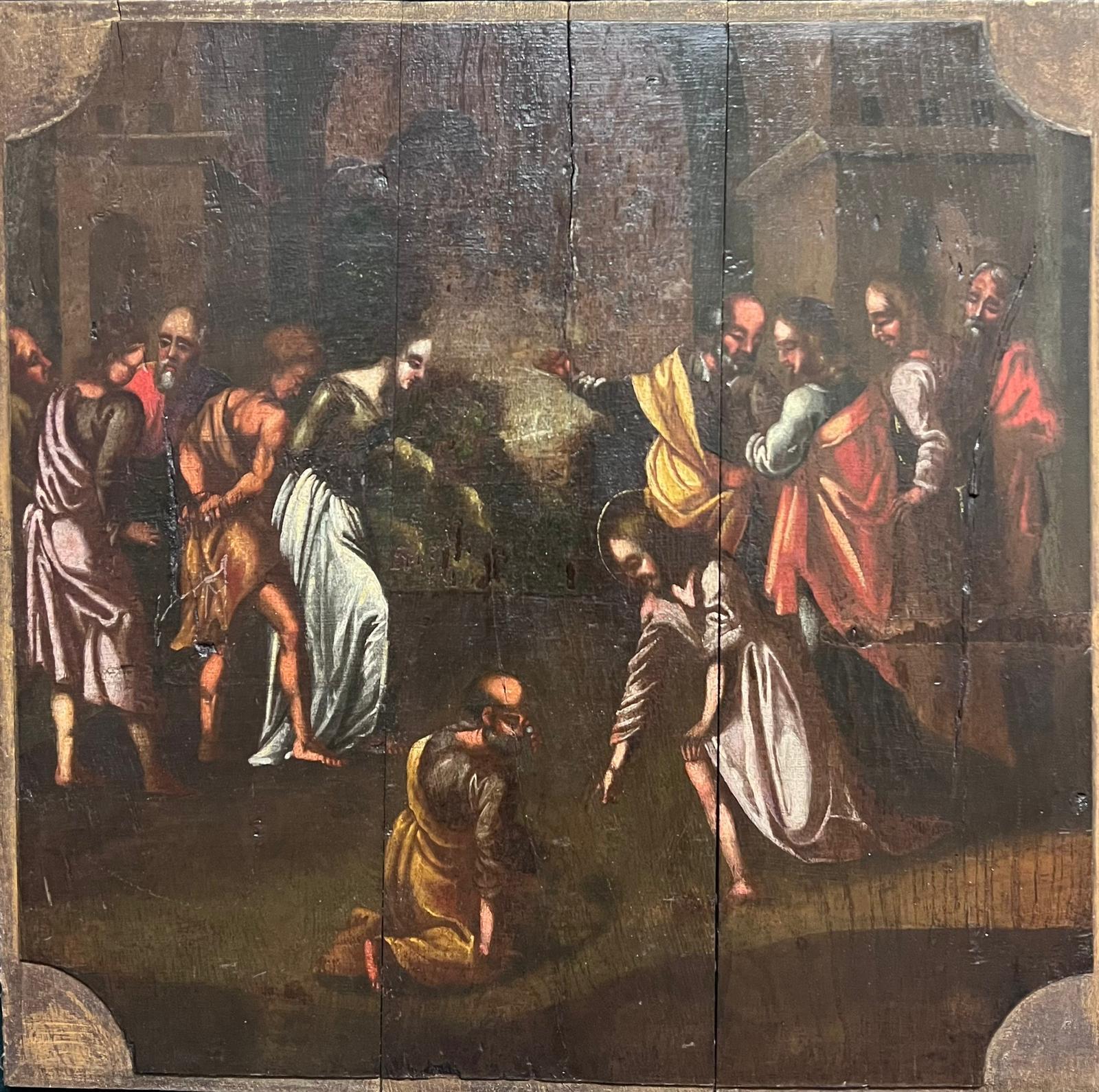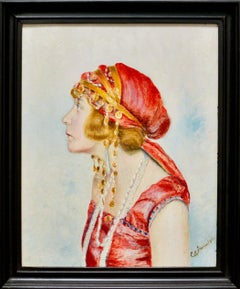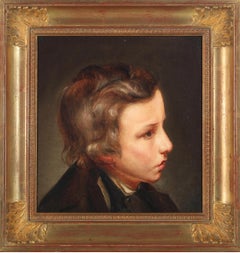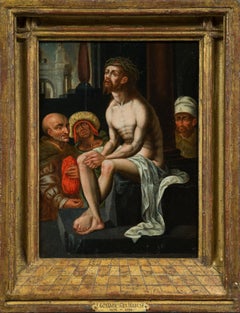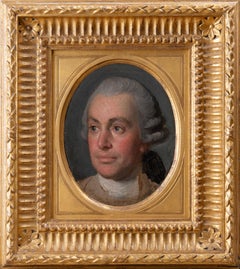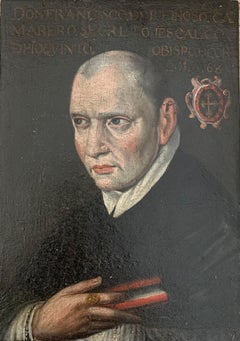Items Similar to 17th Century Portrait of John Calvin
Want more images or videos?
Request additional images or videos from the seller
1 of 8
Unknown17th Century Portrait of John Calvin
About the Item
A Rare 17th-Century Portrait of John Calvin
This small interesting portrait, of John Calvin (1509–1564) offers a rare glimpse into the enduring legacy of the French-Swiss reformer. Painted by an anonymous artist, it dates back to the 17th century and bears the inscription "IOANNES CALVINVS" at the top. Portraits of Calvin, a pivotal figure in the Protestant Reformation and the founder of Calvinism, are exceedingly scarce. The present work exemplifies the classical depictions seen in other known portraits of him, making it an interesting piece for collectors and historians alike.
The portrait is painted within an oval frame set against a neutral background, originally off-white or light brown but now darkened due to varnish discoloration. Measuring 20 x 17.5 cm (excluding the frame), it is executed on a rectangular oak wood panel. Despite its unrestored condition and the accumulation of surface dirt and varnish discoloration, the underlying painting remains in good condition, save for minor paint losses in the outer edges and some older retouching in select areas.
John Calvin: The Man Behind the Portrait
John Calvin, born Jean Cauvin in 1509 in Noyon, Picardy, France, was a towering figure of the Protestant Reformation. His teachings laid the foundation for the Calvinist doctrine, which significantly influenced religious movements in Switzerland, France, Germany, the Netherlands, and Scotland. Calvin’s ideas even reached England and the United States, shaping Protestant thought in ways that surpassed the influence of Martin Luther in some regions.
A scholar and theologian, Calvin initially pursued studies in theology and law before embracing humanistic studies. His theological journey began with a decisive break from Catholic doctrine, inspired by his studies of the Bible and Martin Luther’s writings. By 1533, Calvin openly championed evangelical beliefs, becoming a leader among reformers in Paris. However, persecution forced him to flee to Basel in 1534, where he penned his seminal work, Institutio Christianae Religionis (1536), a systematic presentation of Reformed theology.
Calvin’s tenure in Geneva marked his most significant contribution to the Reformation. After being expelled in 1538 due to his strict moral and ecclesiastical reforms, he returned in 1541 at the city’s request. There, he established a rigorous church order and founded the Academy of Geneva in 1559, which became a center for Reformed theology and education. Calvin’s legacy extended beyond his lifetime, profoundly shaping Protestant traditions worldwide.
Artistic and Historical Significance
This portrait captures Calvin’s intellectual gravitas and his role as a leading reformer during the 16th century. The 17th-century artist, though anonymous, adhered to the traditional iconography associated with Calvin, presenting him with a dignified and contemplative demeanor. Such works are rare not only because of their subject but also due to the limited production of portraits depicting Protestant reformers during a period dominated by Catholic art commissions.
From an art collector’s perspective, this painting offers a convergence of religious history, portraiture, and early modern craftsmanship. The unrestored condition provides an opportunity for careful conservation, preserving the authenticity and patina that reflect its age and journey through time. Its small size and intimate composition make it a compelling addition to any collection focused on Reformation history, early modern art, or theological figures.
This 17th-century portrait of John Calvin represents an artifact of Reformation history and a testament to the enduring impact of his theological legacy. Rare and historically interesting, it stands as both a work of art and a piece of cultural heritage.
- Dimensions:Height: 11.82 in (30 cm)Width: 10.83 in (27.5 cm)Depth: 1.19 in (3 cm)
- Medium:
- Movement & Style:
- Period:
- Condition:It is presently unrestored, surface is heavily discolored by dirt and discoloration of the varnish. Good condition under all the dirt except for some small paint losses in the outer areas of the painting and there are some areas old retouching paint.
- Gallery Location:Stockholm, SE
- Reference Number:1stDibs: LU2608215628962
About the Seller
5.0
Gold Seller
Premium sellers maintaining a 4.3+ rating and 24-hour response times
1stDibs seller since 2023
14 sales on 1stDibs
Typical response time: <1 hour
- ShippingRetrieving quote...Shipping from: Stockholm, Sweden
- Return Policy
Authenticity Guarantee
In the unlikely event there’s an issue with an item’s authenticity, contact us within 1 year for a full refund. DetailsMoney-Back Guarantee
If your item is not as described, is damaged in transit, or does not arrive, contact us within 7 days for a full refund. Details24-Hour Cancellation
You have a 24-hour grace period in which to reconsider your purchase, with no questions asked.Vetted Professional Sellers
Our world-class sellers must adhere to strict standards for service and quality, maintaining the integrity of our listings.Price-Match Guarantee
If you find that a seller listed the same item for a lower price elsewhere, we’ll match it.Trusted Global Delivery
Our best-in-class carrier network provides specialized shipping options worldwide, including custom delivery.More From This Seller
View AllEarly 20th century Woman Profile Portrait in a Red Dress.
Located in Stockholm, SE
A small colorful and interesting profile portrait of a blond woman dressed in a red dress and wearing lots of jewelry also on her head scarf. Signed but unfortunately not identified...
Category
Early 20th Century Other Art Style Portrait Paintings
Materials
Oil, Wood Panel
Portrait of a Boy in Profile
Located in Stockholm, SE
The painting titled Portrait of a Boy in Profile, likely by Friedrich Wasmann (1805–1886), exemplifies the refined portraiture characteristic of the Biedermeier period. Executed in o...
Category
Mid-19th Century Other Art Style Portrait Paintings
Materials
Canvas, Oil, Cardboard
Portrait of a Russian Artist or Dignitary
Located in Stockholm, SE
This 19th-century oil on canvas portrait depicts a distinguished male figure—probably Russian and possibly an artist or a dignitary—with a striking resemblance to the renowned Russia...
Category
19th Century Portrait Paintings
Materials
Canvas, Oil
19th Century, Portrait of a Young Girl
Located in Stockholm, SE
A young girl with a bob haircut, gazing downward, wrapped in a shawl or blanket. A red hairband adorns her head. Oil on canvas mounted on cardboard, this captivating portrait, painte...
Category
1880s Other Art Style Portrait Paintings
Materials
Canvas, Oil, Cardboard
Capriccio View with Classical Ruins and Santa Maria della Salute
By Gaetano Vetturali (Lucca, 1701-1783)
Located in Stockholm, SE
A Venetian capriccio view with classical architectural ruins and in the background the church of San Giorgio Maggiore and the Church of Santa Maria della Salute next to the Grand Can...
Category
1770s Old Masters Landscape Paintings
Materials
Canvas, Oil
Last Judgement, 17th or 18th Century Follower of Hieronymus Bosch
Located in Stockholm, SE
An interesting 17th or possibly 18th century painting of the Last Judgement by a probably Dutch follower of Hieronymus Bosch (1450-1516). It is in fair condition with some paint loss...
Category
17th Century Old Masters Figurative Paintings
Materials
Oil
You May Also Like
Christ on the Cold Stone – After Jan Gossaert (Mabuse)
Located in Stockholm, SE
This striking devotional image, painted by a follower of Jan Gossaert, represents one of the most influential compositions of the Northern Renaissance: Christ on the Cold Stone, or C...
Category
16th Century Old Masters Figurative Paintings
Materials
Oil, Wood Panel
18th century portrait of the painter Nathaniel Dance
Located in London, GB
Collections:
Robert Gallon (1845-1925);
Private Collection, UK.
Oil on canvas laid down on panel
Framed dimensions: 11.5 x 10 inches
This highly engaging, previously unpublished portrait by Johan...
Category
18th Century Old Masters Portrait Paintings
Materials
Oil, Wood Panel, Canvas
Portrait of William Herbert, 3rd Earl of Pembroke, Early 17th Century Portrait
Located in London, GB
English School, (circa 1600)
Portrait of William Herbert, 3rd Earl of Pembroke
Oil on panel, oval
Image size: 29¼ x 23⅞ inches
Painted wooden frame
Provenance:
176, Collection of Francis Greville, 1st Earl of Warwick.
The Trustees of the Lord Brooks’ Settlement, (removed from Warwick Castle).
Sotheby’s, London, 22nd March 1968, lot 81.
Painted onto wooden panel, this portrait shows a dark haired gentleman in profile sporting an open white shirt. On top of this garments is a richly detailed black cloak, decorated with gold thread and lined with a sumptuous crimson lining. With the red silk inside it’s all very expensive and would fall under sumptuary laws – so this is a nobleman of high degree.
It’s melancholic air conforms to the contemporary popularity of this very human condition, evident in fashionable poetry and music of the period. In comparison to our own modern prejudices, melancholy was associated with creativity in this period.
This portrait appeared in the earliest described list of pictures of Warwick castle dating to 1762. Compiled by collector and antiquary Sir William Musgrave ‘taken from the information of Lord & Lady Warwick’ (Add. MSS, 5726 fol. 3) is described;
‘8. Earl of Essex – an original by Zuccharo – seen in profile with black hair. Holding a black robe across his breast with his right hand.’
As tempting as it is to imagine that this is a portrait of Robert Devereux, the 2nd Earl Essex, we might take this with a pinch of salt. Its identification with this romantic and fatal Elizabethan might well have been an attempt to add romance to Warwick Castle’s walls. It doesn’t correspond all that well with Essex’s portraits around 1600 after his return from Cadiz. Notably, this picture was presumably hung not too far away from the castle’s two portraits of Queen Elizabeth I. The first, and undoubtedly the best, being the exquisite coronation portrait that was sold by Lord Brooke in the late 1970s and now hangs in the National Portrait Gallery. The second, described as being ‘a copy from the original at Ld Hydes’, has yet to resurface.
The portrait eventually ended up being hung in the State Bedroom of Warwick Castle.
Archival documents present one other interesting candidate. The Greville family’s earliest inventory of paintings, made in 1630 at their home Brooke House in Holborn, London, describes five portraits of identified figures. All five belonged to the courtier, politician and poet Sir Fulke Greville (1554-1628), 1st Baron Brooke, and were hung in the ‘Gallerie’ of Brooke House behind yellow curtains. One of them was described as being of ‘Lord of Pembrooke’, which is likely to have been William Herbert (1580-1630), 3rd Earl of Pembroke. William was the eldest son of Greville’s best friend’s sister Mary Sidney, and was brought up in the particularly literary and poetically orientated household which his mother had supported. Notably, the 3rd Earl was one of the figures that Shakespeare’s first folio was dedicated to in 1623.
The melancholic air to the portrait corresponds to William’s own pretensions as a learned and poetic figure. The richness of the robe in the painting, sporting golden thread and a spotted black fabric, is indicative of wealth beyond that of a simple poet or actor. The portrait’s dating to around the year 1600 might have coincided with William’s father death and his own rise to the Pembroke Earldom. This period of his life too was imbued with personal sadness, as an illicit affair with a Mary Fitton had resulted in a pregnancy and eventual banishment by Elizabeth I to Wilton after a short spell in Fleet Prison. His illegitimate son died shortly after being born. Despite being a close follower of the Earl of Essex, William had side-stepped supporting Devereux in the fatal uprising against the Queen and eventually regained favour at the court of the next monarch James I.
His linen shirt is edged with a delicate border of lace and his black cloak is lined on the inside with sumptuous scarlet and richly decorated on the outside with gold braid and a pattern of embroidered black spots.
Despite the richness of his clothes, William Herbert has been presented in a dishevelled state of semi-undress, his shirt unlaced far down his chest with the ties lying limply over his hand, indicating that he is in a state of distracted detachment. It has been suggested that the fashion for melancholy was rooted in an increase in self-consciousness and introspective reflection during the late 16th and early 17th centuries.
In contemporary literature melancholy was said to be caused by a plenitude of the melancholy humor, one of the four vital humors, which were thought to regulate the functions of the body. An abundance of the melancholia humor was associated with a heightened creativity and intellectual ability and hence melancholy was linked to the notion of genius, as reflected in the work of the Oxford scholar Robert Burton, who in his work ‘The Anatomy of Melancholy’, described the Malcontent as ‘of all others [the]… most witty, [who] causeth many times divine ravishment, and a kind of enthusiamus… which stirreth them up to be excellent Philosophers, Poets and Prophets.’ (R. Burton, The Anatomy of Melancholy, London, 1621 in R. Strong, ‘Elizabethan Malady: Melancholy in Elizabethan and Jacobean Portraits’, Apollo, LXXIX, 1964).
Melancholy was viewed as a highly fashionable affliction under Elizabeth I, and her successor James I, and a dejected demeanour was adopted by wealthy young men, often presenting themselves as scholars or despondent lovers, as reflected in the portraiture and literature from this period. Although the sitter in this portrait is, as yet, unidentified, it seems probable that he was a nobleman with literary or artistic ambitions, following in the same vain as such famous figures as the aristocratic poet and dramatist, Edward de Vere...
Category
Early 17th Century Old Masters Portrait Paintings
Materials
Oil, Wood Panel
Spanish school. Secretary of Pope Pius V, abbot of Husillos, bishop of Córdoba.
Located in Firenze, IT
Portrait of Francisco de Reynoso y Baeza.
Secretary of Pope Pius V, abbot of Husillos and bishop of Córdoba. Francisci de Reynoso.
Early 17th century.
Small-format portrait from the late Renaissance period.
Spanish school.
Size: Cm 19 x Cm 13.5
Oil on wooden panel.
On the back the fine tablet is strengthened (already in ancient times) by a sheet of parchment.
About 1600-1610.
As often in Mannerist / Late Renaissance portraits, the image of the character is accompanied by the writing that runs at the top, adding a celebratory, historicising touch to the effigy. Let's bring back the sentence here:
DON FRANCISCO DE REINOSO. CAMARERO SECRETO IESCALCO PIO QUINTO OBISCOPO CORDOBA. 68 (? O 7?)
(1534, Autillo de Campos, Spain - 1601, Córdoba)
Francisco de Reynoso was a Spanish cleric, chief chamberlain, and secretary to Pope Pius V, abbot of Husillos, and bishop of Córdoba.
He was the fourth of eleven children. His father was the seventh Lord of Autillo de Campos, and his mother was Juana de Baeza y de las Casas, daughter of Manuel de Baeza, a lawyer of the Royal Council and at the Court of Valladolid.
Francisco de Reynoso was deeply devoted to the Virgin Mary and showed a strong inclination toward religion and piety from an early age.
He studied Latin, arts, and theology at the University of Salamanca.
In 1562, he traveled to Rome with his brothers Pedro and Luis.
In January 1566, following the death of Pope Pius IV, Cardinal Antonio Michele Ghislieri was elected pope, becoming Pius V. From this period until Ghislieri's death in 1572, Francisco de Reynoso served as his chief chamberlain and secretary.
After Pope Pius V died, Francisco de Reynoso returned to Spain and lived for several years in the city of Palencia, where his brother Manuel was a canon.
He supported the Society of Jesus when it was established in Palencia, providing alms to the school's clergy and funding chairs of Letters and Theology at his own expense, as well as donating a significant number of books.
During the brief outbreak of the Black Plague...
Category
17th Century Old Masters Portrait Paintings
Materials
Parchment Paper, Oil, Wood Panel
Large 17th Century Dutch Old Master Oil Painting on Wood Panel Biblical Scene
Located in Cirencester, Gloucestershire
Biblical Figures, Large Gathering around Christ?
Dutch Old Master, early 17th century
oil painting on wood panel, stuck on velvet backing board
velvet board: 27 x 29 inches
board: 25.5 x 26 inches
provenance: private collection, France
condition: good and sound condition, obvious old panel...
Category
Early 17th Century Old Masters Figurative Paintings
Materials
Oil, Wood Panel
Portrait of a Lady in an Elaborate Ruff and White Coiff c.1616, Oil on Panel
Located in London, GB
This exquisite oil on panel portrait, depicts a young lady wearing the most elaborate and costly items of the period - the Dutch coif or coronet of sheer lawn with lace, the lavishly...
Category
17th Century Old Masters Portrait Paintings
Materials
Oil, Wood Panel
Recently Viewed
View AllMore Ways To Browse
Old England Paris
17th Century Figures
17th Century German
17th Century Wood Panels
Antique Catholic Art
Oval Wood Panel
17th Century Oak Panels
Religious Netherlands
Religious Oil Painting 17th Century
Set Of Oval Paintings
16th Century Scotland
Antique Catholic Painting
17th Century Scotland
Antique French Bible
Antique German Bible
Rare Antique Bible
Rare Antique Bibles
Rare And Antique Bibles
